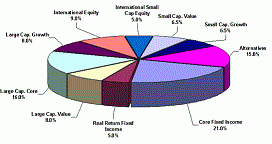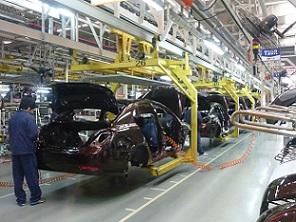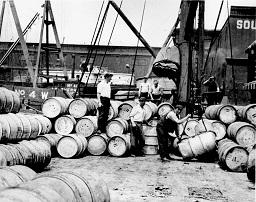Product costing is used to allocate costs, such as materials costs, direct labor costs, and manufacturing overhead, to units of production. Product costs are then used to prepare reports and financial statements, predict costs based on different levels of activity, analyze cost behavior, and determine relevant costs for decision-making.
Total Cost (TC) = Variable Cost (VC) x # of Units + Fixed Costs (FC)
Variable Costs: On a per-unit basis, variable costs are constant. However, total variable costs increase or decrease in proportion to changes in the level of activity.
Step Variable Costs: Step variable costs remain constant over intervals of activity, but increase or decrease as the activity level rises or falls to a new interval level. For example, imagine a new worker must be hired for every 1,000 units of production. The additional labor cost is a step cost that goes up every 1,000 units. The trick is to plan production so step costs are maximized; for example, it may be beneficial to produce X999 units to maximize production without having to hire a new worker.
Fixed Costs: Total fixed costs (often indirect costs or overhead) are not affected by the level of activity within a relevant range. However, the fixed cost per unit decreases as the activity level rises, and increases as the activity level falls.
Mixed Costs: Mixed costs are expenses that contain both variable and fixed elements. Electricity is a common mixed cost. A basic electricity bill for heating, lighting and appliances will be fixed, regardless of how active the business is. If a manufacturing business runs its machinery longer, or a hospital takes in more patients, their electricity bill will rise or fall variably with the level of activity.
Absorption Costing: Absorption or full costing takes all manufacturing costs, fixed and variable, and assigns them to each unit of production. Absorption costing is used in both process and job-order costing.
Variable Costing: (also called Direct Costing or Marginal Costing) treats only those costs of production that vary with output as product costs. Variable costing is useful in looking at income from a contribution approach and conducting a CVP analysis because it separates variable and fixed costs. The cost of a unit of product consists of direct materials, direct labor, and variable overhead. Fixed manufacturing overhead, and both variable and fixed selling as well as administrative expenses are treated as period costs and deducted from revenue as incurred.
Product Costing
BrainMass Categories within Product Costing
Cost Allocation of Service Department Costs

Cost allocation is used to allocate service department costs to the departments that actually consume these costs.
Segment Reporting

A segment in an organization is simply a part of the organization or an activity that managers would like financial information from in order to make decisions and evaluate performance.
Activity-Based Costing

Activity-based costing looks at all activities that cause the consumption of overhead resources. Costs are then attributed to products or customers based on the extent that the activity is used up by the product.
Job-Order Costing

Job-order costing is best suited where a business manufactures or produces many different products each period, products are manufactured-to-order, and the unique nature of each order requires tracing or allocating costs to each job and maintaining a cost record for each job.
Process Costing

Process costing is appropriate where there are many units of a single product, each are indistinguishable from other units, and the identical nature of each unit of product makes it reasonable and efficient to assign the same average cost per unit.
Transfer Pricing

Transfer prices are the prices at which internal company departments, segments or division transfer goods or services to one another.
BrainMass Solutions Available for Instant Download
Break-even analysis of "The Automotive Supply Company"
Scenario: The Automotive Supply Company has a small plant that produces speedometers exclusively. Its annual fixed costs are $30,000, and its variable costs are $10/unit. It can sell a speedometer for $25. 1) How many speedometers must the company sell to break even? 2) What is the break-even revenue? 3) The company sold
Bakersfield Corp. cupcake break even problem
Bakersfield Corporation sells cupcakes for $3. The following is the projected income statement for 2014. Variable costs are the cost of the cakes, $1 each, plus a 10% sales commission paid to the worker. Sales $120,000 Cost of cakes Sold 40,000
Accounting Cost Estimation
See the attachment for full details. Select the graph that matches the numbered manufacturing cost data. Indicate by letter which graph Best fits the situation or item described. (· (Click to view the graphs). The vertical axes of the graphs represent total cost, and the horizontal axes represent units produced during
Drilling Innovations : Traditional versus Activity Based Costing
Drilling Innovations : Traditional versus Activity Based Costing Describe the production characteristics (for example, high-volume, specialty, etc.) of the three products manufactured by Drilling Innovations, Inc. in our case study. Describe the characteristics of products which would suggest it would be better to use ABC
ABC Costing for Sola Systems; profit by product region panel
Sola Systems, a company focussed on clean, energy products assembles and sells two types of solar panels, Panel A and Panel B. The company's sales occur in two regions - One is called Northern and incorporates Queensland, New South Wales and the Northern Territory. The other is called Southern and incorporates Victoria, Tasmania
Blue Ridge Manufacturing: Activity Based Costing
The cost accounting system is fairly sophisticated with respect to variable product costs, but thus far indirect costs have been allocated to products based on their contribution margin. Management realized that many general overhead items represented resources consumed in proportions different than the relative gross profit (c
Holly Manufacturing Case
Holly Manufacturing Company produces two cello models. One is a standard acoustic cello that sells for $600 and is constructed from medium-grade materials. The other model is a custom-made amplified cello with pearl inlays and a body constructed from special woods. The custom cello sells for $900. Both cellos require 10 hours o
Product Costing: ZamGabra Manufacturing Company
a) In job order cost systems, actual direct materials and actual direct labour are charged to the work in process account; however, an estimated amount of overhead is charged to the account. Why is overhead accounted for differently than the other costs of production? Provide an example. b) On December 31, 2012, ZamGabra Manu
Rocky Mountain Traditional vs Activity-Based Costing
Rocky Mountain Corporation makes two types of hiking boots - Xactive and Pathbreaker, data concerning these two product lines appear below: Xactive Pathbreaker selling price per unit $132
Standard Costing Problem for Petty Petroleum, Inc
Petty Petroleum, Inc. uses various chemicals to manufacture its products. Variance data for last month for three primary chemicals used in production are as follows (F indicates a favorable variance; U indicates an unfavorable variance): X42
Current Costing Model
What are the strengths and weaknesses of the current costing model?
Developing Unit Costs Using Normal Costing
The Coastal Landscaping and Snow Removal company uses normal costing to assign overhead costs to the firm's various jobs. Labor is charged to jobs at $25 per hour and for the upcoming winter session, overhead is estimated at $200,000 for $10,000 hours of activity. A. Using normal costing, what would be the total charge for re
Fruit Snacks Corporation: Standard Costing, variances calculated and explained with formula defintion and paths.
Fruit Snacks Corp Inc. makes lunchbox style fruit snacks. The owner of the company is setting up a standard cost system, and she collected the following data for one of the company's products - fruit chews. The data below pertain only to the fruits used in the product. Material requirements, kilograms of fruit per dozen
Product Costing- Traditional and Activity-Based
A corp produces 200,000,000 units if produce X and 80,000,000 of product Y with the following costs and machine hours. Direct costs Prod X Prod Y Total (material plus labor) $18,000,000 $
Activity-Based Costing: Hampstead Company
Hampstead company's order entry department has 20 order entry operators. The cost associated with these 20 operators (salaries, fringe benefits, and supervision, as well as occupancy and equipment costs) is $873,600 per year. After taking into account vacations and holidays, Hampstead calculated that each operator worked about 1
Walters Company: Process further?
Walters Company produces 15,000 pounds of Product A and 30,000 pounds of Product B each week by incurring a joint cost of $400,000. These two products can be sold as is or processed further. Further processing of either product does not delay the production of subsequent batches of the joint product. Data regarding these two pro
Traditional Costing and Activity-Based Costing
The current cost accounting system allocates manufacturing support costs to to the the two products on the basis of direct labor hours. The company has estimated that this year it will incur $1M in manufacturing support costs and will produce 5,000 units of the deluxe model and 40,000 units of the regular model. The deluxe model
Activity Based Costing in a Restaurant
Gino's Restaurant is a popular restaurant of Boston, Massachusetts. The owner of the restaurant has been trying to better understand costs at the restaurant and has hired a student intern to conduct an activity-based costing study. The intern, in consultation with the owner, identified the following major activities: Activi
Bravo Baking Standard Costing Variance Analysis Spreadsheet
Bravo Banking uses standard costing to analyze it performance. The data (attached) shows standard cost per unit of $5.11 Part a. Compute the material price and quantity variance. Labor efficiency and labor rate variances. See attached file.
Guard Company invests in a new piece of equipment costing $4
22. Guard Company invests in a new piece of equipment costing $40,000. The equipment is expected to yield the following amounts per year for the equipment's 4-year useful life: Cash Revenues $60,000 Cash Expenses $32,000 Depreciation Expense
Case 4.63 Activity-based costing in health care
Insurance companies and the federal government are restricting reimbursements to health care facilities and causing these facilities to seek cost reductions and more accurate tracing of costs without reducing the quality of care. Lisa Whelan, the administrator of Community Hospital, is exploring whether ABC can be applied to her
Memphis Electrical Target Costing. Would you produce such a motor if you were a manager at Memphis? Explain.
makes small electric motors for a variety of home appliances. Memphis sells the motors to appliance makers, who assemble and sell the appliances to retail outlets. Although Memphis makes dozens of different motors, it does not currently make one to be used in garage-door openers. The company's market research department has d
P 12-11 Zinc Faucets standard costing materials
Zinc Faucets The standard cost sheet calls for 80 pounds of zinc per batch of 70 faucets. Zinc has a standard price of $5.10 per pound. One thousand pounds of zinc are purchased for $5,530. Ten batches of the faucets are produced, and 840 pounds of zinc are used. There was no beginning zinc inventory. All variances are calcul
Target Costing.
Traditional wisdom was to create a product, figure out the cost, add a profit margin, and then determine the price. Target costing is another way to "watch" costs and setting prices. See references below. Accounting for Management. (n.d.). Target Costing Approach to Pricing. Retrieved from http://www.accountingformanagement.c
Drucker Seven Deadly Sins: Target Costing vs Market Pricing
Drucker argues that one of the seven deadly business sins is to base prices on costs, which means first measuring the current cost of a product or service and then "marking it up" by adding a profit margin. He blames the disappearance of the US consumer-electronics industry in part on its practice of basing prices on costs. Can
Activity-based costing for a property investment company.
Bovis Homes. See their annual report http://www.edocumentview.co.uk/bovishomes2012/2012/103621/default.htm?voting=false 1. Assess how Activity-Based Costing can contribute to enhancing shareholder wealth. 2. Provide a rationale for why Bovis Homes might need activity-based costing. - Their products include Houses and A
Activity-Based Costing (AB)
Can you help me with the following question? 1. The following is a list of activities that occur for a company that sells many different types of products. Please classify each as either unit-level (U), batch level (B), product level (P), or organization sustaining activity (O). a. Packing labor wages b. Materials-ha
Costing Systems in Health Care
Any cost that a health care manager can authorize or directly influence is a controllable cost. Examples of non-controllable costs for the business include: taxes, interest, costs mandated in the fulfillment of contracts, costs of having the buildings ADA accessible, costs associated with complying with all minimum standards for
Honey Butter, Inc. Process Costing
Honey butter, Inc. Manufactures a product that goes through two departments prior to completion, the Mixing Department followed by the Packaging Department. The following information is available about work in the first department. The Mixing Department, during June. Percent Completed Units Materials Conversions Work in Pro
Target Costing Problem
Target Cost Baker Plumbing Fixtures is developing a preplumbed acrylic shower unit. The team developing the product includes representatives from marketing, engineering, and cost accounting. To date, the team has developed a set of features that its plans on incorporating in the unit, including a seat, two shower heads, four
